“Build it, and they will come” is definitely true now as people are coming –– by the thousands –– not to see a baseball game but to tour a magnificent, state-of-the art, climate-control structure that many are calling “The Eighth Wonder of the World.” It is Globe Life Field, the new home of the Texas Rangers, and it opened its gates for First Look Tours in June.
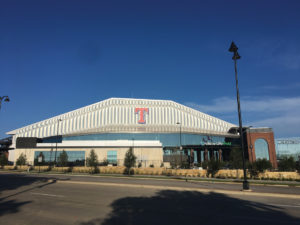
Photo by Ozzie Garza.
For me, it meant going back to work as I began my fourth year as a stadium tour guide.
It was a day many of us tour guides had been anxiously awaiting. I now know how players feel on Opening Day, as I experienced a little anxiety and nervousness prior to giving my first public tour of the new stadium. I had my cheat notes at the ready for quick glances. As a tour guide, one has to guard against giving erroneous information.
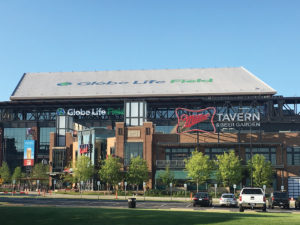
Photo by Ozzie Garza.
Joining me on this history-making tour of the Rangers’ new home were the Rangers’ photographer, the club’s videographer, and the team mascot, Rangers Captain.
Tour coordinator Michelle Robinson has instructed us to make our tours educational, enjoyable, and entertaining. “We want our tours to be a memorable experience for our guests, so they will come back and also tell their friends about their tour experience.”
All of my fellow tour guides certainly try to do that.
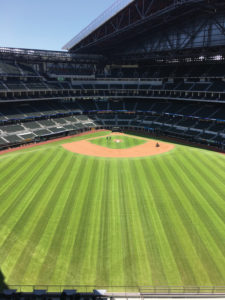
Photo by Ozzie Garza.
The more than two dozen other tour guides and I received extensive training in May going over the routes and script and familiarizing ourselves with the huge seven-level facility that encompasses 1.8 million square feet.
There are also some strict restrictions that have been put in place because of the COVID-19 pandemic. All tickets must be purchased online. Tickets for First Look Tours are $25 for adults and $15 for children (ages 4-14), and children under 36 inches are admitted free. Before entering the gates, each person has their temperature checked and is given a cloth face covering with the Globe Life Field logo in front.
The Rangers are adhering to guidelines from the Centers for Disease Control and Prevention urging social distancing. Each tour guide must wear a protective face covering and avoid any physical contact with guests.
These strict guidelines have not deterred fans as they anxiously await their first look at this modern marvel of a stadium. They enter Globe Life Field through the main north entrance, which many are calling “the stadium’s front door.”
“Being able to finally host our fans in this beautiful state-of-the-art facility is thrilling,” said Lindsey Hopper, director of Globe Life Field tours and experiences. “Rangers fans have waited a long time for this. We are honored to host them on our tours and share in their excitement when they step inside for the first time.”
*****
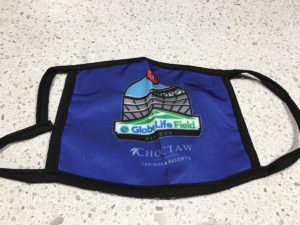
Photo by Ozzie Garza.
One of the first things guests see as they walk in is a series of displays honoring the team’s legendary players and historical moments. There are sculptured displays of the players’ jerseys whose numbers have been retired –– Nolan Ryan, Ivan Rodriguez, Johnny Oates, Adrian Beltre, and Michael Young. There are also two displays of the team’s joyous celebrations after winning the American League championships in 2010 and 2011.
I congratulated my group, informing them that they were making history by being the first folks to take a public tour of Globe Life Field.
Once inside, guests quickly experience a comfortable 72 degrees throughout the stadium. I mentioned that when the final out was recorded at Globe Life Park on Sept. 29, 2019, the temperature on the scoreboard read 94 degrees. It would be the last time the Rangers would play their home games in 90-degree temperatures. It would also be the last time Rangers fans would endure sauna-like conditions watching their home team play.
As the tour began, I gave the group a history of the Rangers franchise and home parks. The team moved to Arlington in 1972 from Washington, D.C., where they were the Washington Senators. Moving down here, they couldn’t really be the Texas Senators, so they named themselves after the Texas law enforcement agency. They played in an old minor league park known as Turnpike Stadium, which was the home of the Dallas-Fort Worth Spurs. The stadium was upgraded to bring it up to Major League standards and renamed Arlington Stadium. The team played there for 21 years.
We were walking across the sky bridge on the upper concourse in left field when I pointed out that the arches and bricks along the corridor are a tribute to Globe Life Park, where the team played 26 seasons. The historic park was the site of two World Series, dozens of postseason games, and an All-Star game. Globe Life Park was also the site of a perfect game, when Kenny Rogers retired all 27 batters in order against the Anaheim Angels in 1994.
We then stopped at the Karbach Brewing Sky Porch, sure to be one of the most popular sitting areas of the ballpark as it features some very comfortable rockers.
“It’s like watching the game from your back-porch rocking chair,” said one guest.
It was in this setting that I talked about Globe Life Field, the Rangers’ third home. Groundbreaking for the new park took place on Sept. 28, 2017, with construction beginning the following week. More than 11,000 people worked on the project throughout the construction period. The price tag for this marvelous wonder was $1.2 billion.
“I guess one can say we are keeping up with the Joneses next door,” I told the group.
Some interesting facts and figures about the park: It is located on 13 acres of land and has a seating capacity of 40,300. Seventy percent of the seats are between the foul poles on the home plate side of the field. The seats are two inches wider than the ones in Globe Life Park. The field is 50 feet below street level. There are seven levels, 13 escalators, 54 elevators, 1,450 TV monitors, 20 bars, 11 kitchens, dozens of concession stands, and, perhaps most importantly, 1,100 toilets/urinals.
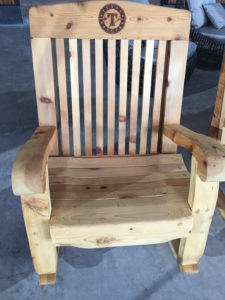
Photo by Ozzie Garza.
However, everyone wanted to know about the roof. As they came in, the first thing many of them did was look up at the roof and stare in amazement. It is certainly a sight to see –– both from the outside and from the inside.
The retractable roof, which opens from east to west, spans about 5.5 acres and weighs 24 million pounds. It is the largest single-panel retractable roof in North America, proving that everything is bigger in Texas.
From second base to the top of the roof is 210 feet, 6 inches. Last year, Joey Gallo hit the highest pop fly at Globe Life Park. It was measured at 207 feet high. While it is unlikely that a batted ball will hit the roof of Globe Life Field, Major League Baseball and the Rangers have discussed the ground rules should that occur.
It takes about 12 to 15 minutes to open the roof, as it moves about 39 feet per minute. To open the roof requires only the push of a single button located at the command center. The operator must keep his finger on the button during the entire process. If the finger comes off the button, the roof is programmed to automatically stop. There are some spotters along the rails to ensure that no objects such as pigeon nests or other obstacles derail the roof’s movement.
“Please don’t push any buttons you may see along the tour route,” I jokingly said. “You may open the roof.”
Prior to the game, it is the Rangers’ decision to have the roof opened or closed. Once the game starts, it then becomes the umpire’s decision. The roof can be opened only once per game and only at the end of an inning.
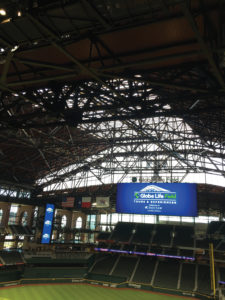
Photo by Ozzie Garza.
As we walked along the concourse, some folks expressed heartbreak at seeing all the empty concession stands, eateries, and premium dining areas.
“This is just sad,” I heard one woman tell her husband. “Just think of all the money that’s being lost by not having games.”
The tour includes a visit to one of the radio broadcast booths. There are 11 of them. I made a comment to one of the youngsters on the tour that if he wanted to be a sports broadcaster or a sportswriter when he grows up, he would have one of the best seats in the house. “I’m going to be a baseball player,” he said, “and will be down on the field, not up here.”
“Go for it,” I said.
While in the booth, I talked about the field and its dimensions. The infield is dirt, the warning track is crushed brick, and the rest of the field is synthetic grass. I noted that the decision to go with turf was based on extensive research, including a kinesiology study with Auburn University that focused extensively on player safety and optimal performance. The Rangers opted for a dual-fiber turf system, which uses a natural sustainable infill called Geofill. Made of coconut husks and fiber, it requires much less watering than natural grass.
Another unique feature is the retractable pitcher’s mound. This gives flexibility to use the stadium for other activities outside baseball that require a flat surface.
I talked about the fence distances, which have been designed to honor the five Rangers whose numbers have been retired by the club. They also represent some historic numbers in the history of the franchise. The left-field line is 329 feet (Adrian Beltre’s No. 29). The left-field power alley is 372 feet (the Rangers’ first year in Arlington, 1972). Centerfield straightaway is 407 feet (Ivan Rodriguez’ No. 7). The deepest distance of the park (both left and right of straightaway centerfield) is 410 feet (Michael Young’s No. 10). The right-field power alley is 374 feet (The Turnaround Gang, who went from 57 to 84 wins in 1974). The right-field line is 326 feet (Johnny Oates’ No. 26). In addition, there is a distance marker in left field at 334 feet from home plate to recognize Nolan Ryan’s No. 34. The distance from home plate straight back to the wall of the field-level suites is 42 feet, which honors Jackie Robinson’s No. 42.
Also, Globe Life Field’s address is 734 Stadium Drive in honor of the Rangers’ two National Baseball Hall of Famers: Ivan Rodriguez (No. 7) and Nolan Ryan (No. 34).
*****
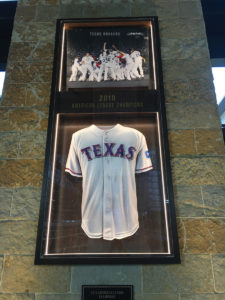
Photo by Ozzie Garza.
During the tour, there were a few players on the field taking batting practice. I asked the group to tell me who hit the first home run in Globe Life Field.
“Gallo,” “Choo,” “Odor,” came the reply.
“Nobody,” I said. “They haven’t played a game yet.”
There was still more to see, so we headed down to the Lexus Club on the field level behind home plate and went to one of the home plate suites.
“If you want to be on national TV, this is the place to sit,” I said. “From here, you are actually closer to the batter than the pitcher is.”
In addition to visiting some of the other suites and clubs, we went to the visitors’ clubhouse, where we saw the dressing room and batting cage. To get there, we went to the tunnel, which is big enough to accommodate an 18-wheeler, making it easier to load and unload all of the team’s equipment before and after every trip.
Because some of the Rangers were on the field at the time, my tour group was not allowed to visit the home clubhouse, which is about an acre in size. It is the largest clubhouse in Major League baseball.
The hour-long tour went pretty fast, and we walked about 3,000 steps. I did have to take a peek at my cheat notes when I was asked the size of the two giant video boards. The one in right field is 150 feet by 58 feet. The left field one is 120 feet by 40 feet.
I also informed my group that only two things were brought to the new stadium from Globe Life Park: home plate and the out-of-town scoreboard. Then I noticed Rangers Captain pointing at himself.
“Actually, three things,” I said. “Rangers Captain also came here from the old ballpark.”
He then gave me a thumbs up.
Following the tour, I was asked how the players feel about their new home. Earlier this year I talked to some of the players about Globe Life Field.
Rangers catcher Robinson Chirinos, who played in a climate-control stadium last year in Houston, is glad to once again be playing his home games in an indoor stadium.
“It really makes a big difference,” he said. “When I played here, it would take my body two to three days to recover from the heat. It was tough. Don’t have to worry about that now.”
Newly acquired Rangers third baseman Todd Frazier is also looking forward to playing in the new climate-control stadium.
“It seems that every time we came here to play the Rangers, it would be one of the hottest days of the year,” he said. “It was miserable. That won’t be the case this year, and I’m excited about it.”
Other players have also been impressed by their new home.
“It’s awesome,” said Nick Solak, the Rangers’ 2019 rookie of the year. “I’m definitely looking forward to playing here.”
Earlier this year, Solak and teammates Willie Calhoun, Jose Treviño, and Joey Gallo took some batting practice on the field, hitting a few balls into the outfield stands.
“Really looking forward to hitting in this ballpark,” Gallo said.
Also looking forward to hitting in the new home park is the Rangers’ potential lead-off hitter, Shin-Soo Choo. When asked if he was ready to make history by becoming the first player to hit a home run in the new park, he said he has definitely thought about it.
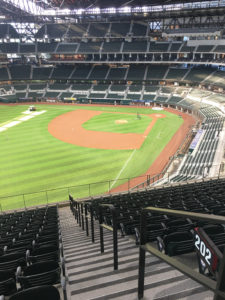
Photo by Ozzie Garza.
“Normally,” he said, “I go up there trying to get on base and see as many pitches as I can, but, hey, if the pitch is there, I’ll swing for the fences.”
Last November, baseball commissioner Rob Manfred toured the construction site and was truly impressed by what he saw. He hinted that Globe Life Field could very well host an All-Star game in the foreseeable future.
“Usually, when we have a community like Arlington that has stepped forward, supported a development like this, we try to bring an All-Star game there relatively proximate to the opening,” Manfred said, “so, without making a commitment, I think that is reasonable to assume.”
Meanwhile, dozens of home games have been postponed so far. Among them were series against the Yankees, Red Sox, Angels, Astros, and the World Series Champions, the Washington Nationals. All premium games that would have certainly sold out.
Also postponed was the Willie Nelson/Chris Stapleton concert, which was scheduled to be the first public event at Globe Life Field.
Instead, the first public event was a high school graduation ceremony that took place on May 29. It was the first of nearly 60 high school graduation ceremonies that have taken place in June and July. More than 60,000 high school seniors have received their diplomas at home plate.
One of the graduates, a softball player disappointed that her senior season was cut short because of the pandemic, slid into home plate to receive her diploma.
While we congratulate the 2020 graduates, we anxiously await the start of the baseball season.
As Rangers vice president for communications John Blake said about this delay, “It’s like getting a nice Christmas present and then being told you can’t use it until months later.”
Well, it’s now time to use that present, as Major League Baseball announced the 2020 baseball schedule last week. The Rangers are set to play the first regular season game ever at Globe Life Field on Friday, July 24, at 7:05 p.m. against the Colorado Rockies. The Rangers will open the 60-game shortened season with a five-game homestand: three games against the Rockies and two games against the Arizona Diamondbacks.
Until further notice, no fans will be allowed at these games as a precaution because of the pandemic.
Even so, “Batter up!”
Ozzie Garza, who serves as a Globe Life Field tour guide, has been writing about the Rangers for more than 20 years. He is a frequent contributor to the Fort Worth Weekly.



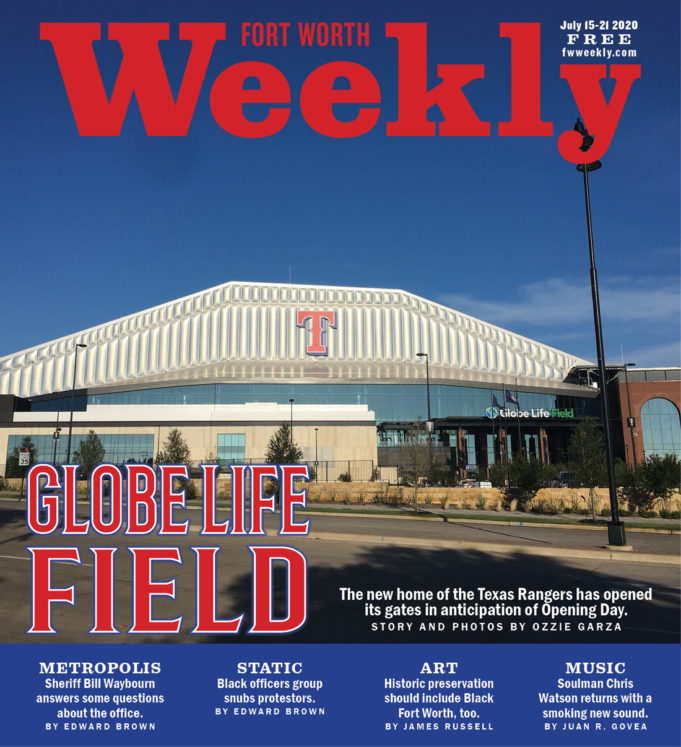









Where can I purchase 2 Rockers like those in GlobeLife Field. Thanks